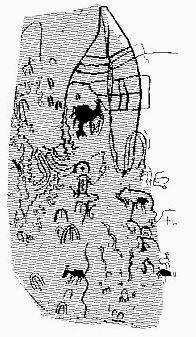***This is a presentation which I recently gave. I have not yet visited these sites.***
My interest in petroglyphs began when I was a child growing up
in the San Luis Valley where petroglyphs seemed to be everywhere. As I aged and
began to delve into art, my interest in petroglyphs continued. I found it
interesting to see how ancient peoples viewed their world and described it in
the artwork they left behind.
The majority of the petroglyphs found in the southeast corner of Colorado are in and around the Comanche National Grasslands and they are quite
unique. They're believed to be Pre-Columbian and of European
Origin. SE Colorado is an area of short-grass prairie with canyons and
hoo doos carved out by the waterways which bring the essence of life to the
area. The Arkansas River flows through here on its way to the Mississippi. But
the Arkansas isn't alone - the Purgatoire River & Apishapa River along with
numerous smaller waterways feed the Arkansas. This area was frequented by various people through the eons. Some
might have been nomads, simply following the herds. Others could have been
explorers, looking for ore to mine or new land to populate.
The mesa tops provided a place to scan the plains for buffalo or
antelope while the canyons offered shelter from the unrelenting sun or sudden
storms. The river bottoms provided fertile land for agriculture. It is amongst
these caves and other niches that the people who visited this area left their
mark. Graffiti of sorts. At least that is what it would be called today. But
this Graffiti wasn't made with cans of paint but rather by scraping and carving
the rock, leaving behind Rock Art. These people were determined to record
events, thoughts, ideas for posterity.
 |
| pecked petroglyph |
 |
| carved petroglyph |
Rock art can be petroglyphs or pictographs. Petroglyphs are
symbols which have been carved into stone - they can be pecked resulting in
round indentations as well as scraped or carved into the rock resulting in a more defined
glyph. Carved glyphs last longer. When creating a glyph, the patina or rock
varnish, is scraped off leaving the bare rock face exposed. Depending on where
the glyph is located - area of the country, location on the rock - a glyph may
remain readable for centuries. Petroglyphs should not be confused with
pictographs - pictographs are painted on.
 |
SE Colorado map
C - Crack cave S - Sun Temple P - Pathfinder |
There is an abundance of rock art here but there are three
specific sites of interest. Crack Cave, Sun Temple and the Pathfinder Site.
These sites have the typical rock art attributed to the Native Peoples of
Colorado but they also have some unusual markings which have been determined to
be an ancient form of writing found in the British Isles and Iberia - all
locations where the ancient Celts lived. This writing is called Ogham.
 |
| Ogham writing on rock in Ireland |
Ogham is the oldest form of writing in Ireland and Scotland. It
can still be seen inscribed on hundreds of large and small stones, on the walls
of some caves, but also on bone, ivory, bronze and silver objects. The Ogham
script was especially well adapted for use on sticks. And sticks were always in
ready supply and easier to carve on than rocks. Ogham writing has been discovered at Stonehenge dating to 2200BCE.
The true origin of Ogham is unknown. A 7th century Irish
text states that the origins of Ogham should be sought in the Near
East. It may have originated in Libya. It is believed that
the Phoenicians came from the region which encompasses Libya and they settled
the areas of Spain where the early Celts lived. The Phoenician later expanded
their journeys to include Ireland and later Scotland and England. As these
skilled seamen settled in new areas, they brought their customs, knowledge and
beliefs with them. The Ogham found in Europe is usually written vertically
while the Ogham carvings here are written horizontally. This may be because it
was easier to find long uninterrupted horizontal surfaces on the rock
walls. Irish monks, centuries ago, translated Ogham into Gaelic which has enabled Ogham to be translated into English.
 |
| Stonehenge - the most well known Archaeo-astronomical site |
All three of the sites I’m going to tell you about are
archaeo-astronomical sites. Archaeo-astronomy is the study of how sky watchers
of the past understood the phenomena in the sky, how they used these
phenomena and what role the sky played in their cultures. Often the people
relied on sunlight and shadow plays striking and passing across targets and
designs which were aligned with Equinox, Solstice and Cross Quarter sunrises
and sunsets. The celestial cycles of the moon, Venus and Mars captivated their
attention, as well. Knowing seasonal durations and transitions was vital to their
success in hunting migratory prey and planting and harvesting crops.
Archaeoastronomy draws on several scientific disciplines, primarily astronomy,
archaeology, anthropology, psychology and epigraphy (the decoding of ancient
inscriptions).
***Part 2 tomorrow!***





